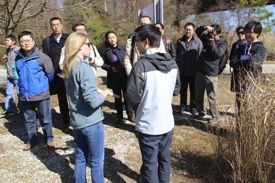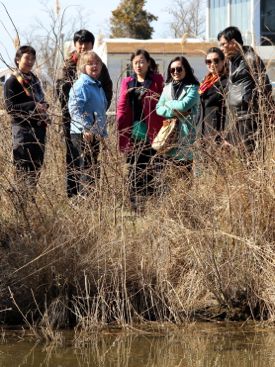Chinese officials visit VIMS
Group from State Oceanic Administration focuses on education
A group of 22 officials from the State Oceanic Administration of China visited William & Mary's Virginia Institute of Marine Science on March 14 to learn about VIMS’ efforts to educate the public on coastal and ocean issues.
Part of the Ministry of Land and Resources, the State Oceanic Administration (SOA) is responsible for supervising and managing China’s marine areas, protecting its coastal environment and maritime rights, and organizing scientific and technical research.
 Haixing “Daniel” Wang, one of several Chinese graduate students in William & Mary’s School of Marine Science at VIMS, says the agency is most similar to NOAA, the U.S. National Oceanic and Atmospheric Administration. Like NOAA, SOA encourages sustainable use of coastal and marine resources. China’s 10,000-mile coastline is home to seven of the world’s 10 largest container ports, accounts for two-thirds of the world’s reported aquaculture production, and like other industrial nations suffers from significant pollution from human activities—most notably excess nutrients from wastewater treatment, use of fertilizer, and the burning of fossil fuels.
Haixing “Daniel” Wang, one of several Chinese graduate students in William & Mary’s School of Marine Science at VIMS, says the agency is most similar to NOAA, the U.S. National Oceanic and Atmospheric Administration. Like NOAA, SOA encourages sustainable use of coastal and marine resources. China’s 10,000-mile coastline is home to seven of the world’s 10 largest container ports, accounts for two-thirds of the world’s reported aquaculture production, and like other industrial nations suffers from significant pollution from human activities—most notably excess nutrients from wastewater treatment, use of fertilizer, and the burning of fossil fuels.
During the SOA visit, Wang joined with fellow graduate students Zhuo Liu and Zhengui Wang, as well as post-doctoral researcher Xin Li, to translate presentations by VIMS administrators and staff, and to informally speak with their compatriots during lunch. Daniel Wang is a Master’s student studying with Assistant Professor Donglai Gong, while Liu and Zhengui Wang are Master’s students in the lab of VIMS Professor Harry Wang. Xin Li works with Professor Mike Unger.
The group was welcomed to VIMS by Dean and Director John Wells, who introduced the Institute’s mission of research, education, and advisory service. They also heard from Associate Dean of Academic Studies Linda Schaffner, who described VIMS’ graduate program, as well as W&M’s new undergraduate minor in marine science. The final presentation came from Marine Education Program Leader Lisa Ayers Lawrence, who discussed the goals and activities of the Marine Advisory Services and Virginia Sea Grant programs at VIMS.
The group’s visit ended with a tour of the VIMS Teaching Marsh led by Outreach Specialist Kattie McMillan and Karen Duhring, a Marine Scientist Supervisor in VIMS’ Center for Coastal Resources Management. The Teaching Marsh is a demonstration wetland used to showcase how marine plants and animals can filter pollutants, reduce shoreline erosion, and provide other ecosystem services.
Heading the Chinese delegation was Hang Li, deputy director at SOA for publicity and education service. Li says “We had a wonderful time at VIMS. It is a pleasant opportunity to share oceanic education experiences between China and the U.S.”
 Liu, who received his undergraduate degree from Xiamen University, says that translating for the group was an “interesting experience because I needed to think of basic Chinese phrases to represent different English phrases, especially some scientific words.” Zhengui Wang, who graduated from Hefei University in Anhui province, adds that “translating is hard, but an important skill.” Li, a graduate of Wuhan University, adds, “I think it is a good chance to communicate with other people.”
Liu, who received his undergraduate degree from Xiamen University, says that translating for the group was an “interesting experience because I needed to think of basic Chinese phrases to represent different English phrases, especially some scientific words.” Zhengui Wang, who graduated from Hefei University in Anhui province, adds that “translating is hard, but an important skill.” Li, a graduate of Wuhan University, adds, “I think it is a good chance to communicate with other people.”
Both Liu and Wang say the group was most interested in the Teaching Marsh. Says Liu, “they considered it a good way to educate the public to know how marsh interacts with surrounding plants and furthers the whole ecosystem.” Li says “The visitors said VIMS is a very beautiful place,” while Zhengui Wang says they remarked that “The sky is so clean.” Daniel Wang says several of the Chinese scientists “showed interest in the York River and the historical towns of York Town and West Point.”
Susan Maples, outreach director at VIMS, says the “visit was a real success, and provided a good opportunity to share the design and goals of our many outreach programs with an international audience.”
VIMS’ focus on informing the public about marine science and ecosystems is a goal that the Chinese group apparently shares. Says Liu, “[Deputy Director Li] shared with me that ‘Chinese schools—especially universities in the field of Marine Science—should introduce more activities to interact with public, with kids, and make this interaction as their responsibility rather than a mandatory task.”
The SOA group arrived at VIMS from Washington, D.C., where they had previously met with officials at the National Science Foundation, the Consortium for Ocean Leadership, and the Society for Ocean Sciences. They are also scheduled to visit the Institute of Marine and Environmental Technology, the National Aquarium, the Maryland Coastal Bays Program, and other East Coast sites before traveling to California to visit with staff at the Aquarium of the Pacific in Long Beach, the Scripps Institution of Oceanography in San Diego, and the Sea Grant program at the University of Southern California in Los Angeles.
The group’s U.S. visit was organized by Cecilia (Siyu) Tang of the Triway International Group in Falls Church, Va.















